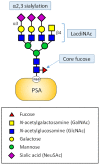Frontiers in mass spectrometry-based clinical proteomics for cancer diagnosis and treatment
- PMID: 36661476
- PMCID: PMC10154896
- DOI: 10.1111/cas.15731
Frontiers in mass spectrometry-based clinical proteomics for cancer diagnosis and treatment
Abstract
Numerous omics studies, primarily genomics analyses, have been conducted to fully understand the molecular biological characteristics of cancer. In recent years, the depth of proteomic analysis, which comprehensively analyzes proteins and molecules that function directly in vivo, has increased dramatically. Proteomics using mass spectrometry (MS) is a promising technology to directly examine proteoforms, including post-translational modifications and variants originating from genomic aberrations. Recent advances in MS-based proteomics have enabled direct, in depth, and quantitative analysis of the expression levels of various cancer-related proteins, as well as their cancer-specific proteoforms, and proteins that fluctuate with cancer initiation and progression in cell lines and tissue samples. Additionally, the integration of proteomic data with genomic, epigenomic, and transcriptomic data has formed the growing field of proteogenomics, which is already yielding new biological and diagnostic knowledge. Deep proteomic profiling provides clinically useful information in various aspects, including understanding the mechanisms of cancer development and progression and discovering targets for diagnosis and drug development. Furthermore, it is expected to make a significant contribution to the promotion of personalized medicine. In this review, recent advances and impacts in MS-based clinical proteomics are highlighted with a focus on oncology.
Keywords: biomarker; cancer; glycoproteomics; mass spectrometry; proteogenomics.
© 2023 The Authors. Cancer Science published by John Wiley & Sons Australia, Ltd on behalf of Japanese Cancer Association.
Conflict of interest statement
K.U. has consulted for LSI Medience Corporation and received compensation. K.U. is also an editorial board member of
Figures





References
-
- Alix‐Panabières C, Pantel K. Clinical applications of circulating tumor cells and circulating tumor DNA as liquid biopsy. Cancer Discov. 2016;6:479‐491. - PubMed
-
- Paul J, Veenstra TD. Separation of serum and plasma proteins for In‐depth proteomic analysis. Separations. 2022;9:89.
Publication types
MeSH terms
Grants and funding
LinkOut - more resources
Full Text Sources
Medical

